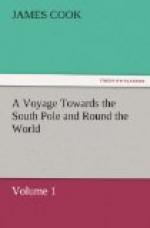The morning, on the 10th of March, being calm, the ship then about four miles from the land, sent the great cutter on shore with the second lieutenant, to find if there was any harbour or good bay. Soon after, it beginning to blow very hard, made the signal for the boat to return several times, but they did not see or hear any thing of it; the ship then three or four leagues off, that we could not see any thing of the boat, which gave us great uneasiness, as there was a very great sea. At half-past one p.m. to our great satisfaction, the boat returned on board safe. They landed, but with much difficulty, and saw several places where the Indians had been, and one they lately had left, where they had a fire, with a great number of pearl escallop shells round it, which shells they brought on board, with, some burnt sticks and green boughs. There was a path from this place, through the woods, which in all probability leads to their habitations; but, by reason of the weather, had not time to pursue it. The soil seems to be very rich; the country well clothed with wood, particularly on the lee side of the hills; plenty of water which falls from the rocks in beautiful cascades, for two or three hundred feet perpendicular into the sea; but they did not see the least sign of any place to anchor in with safety. Hoisted in the boat, and made sail for Frederick Henry Bay. From noon to three p.m. running along shore E. by N., at which time we were abreast of the westernmost point of a very deep bay, called by Tasman, Stormy Bay. From the west to the east point of this bay there are several small islands, and black rocks, which we called the Friars. While crossing this bay we had very heavy squalls and thick weather; at times, when it cleared up, I saw several fires in the bottom of the bay, which is near two or three leagues deep, and has, I doubt not, good places for anchoring, but the weather being so bad, did not think it safe to stand into it. From the Friars the land trenches away about N. by E. four leagues: We had smooth water, and kept in shore, having regular soundings from twenty to fifteen fathoms water. At half-past six we hauled round a high bluff point, the rocks whereof were like so many fluted pillars, and had ten fathoms water, fine sand, within half a mile of the shore. At seven, being abreast of a fine bay, and having little wind, we came-to, with the small bower, in twenty-four fathoms, sandy bottom. Just after we anchored, being a fine clear evening, had a good observation of the star Antares and the moon, which gave the longitude of 147 deg. 34’ E., being in the latitude of 43 deg. 20’ S. We first took this bay to be that which Tasman called Frederick Henry Bay; but afterwards found that his is laid down five leagues to the northward of this.




